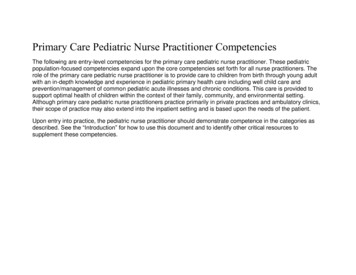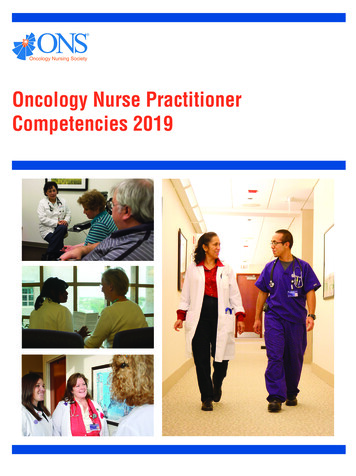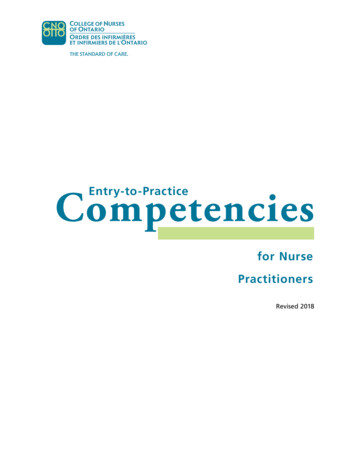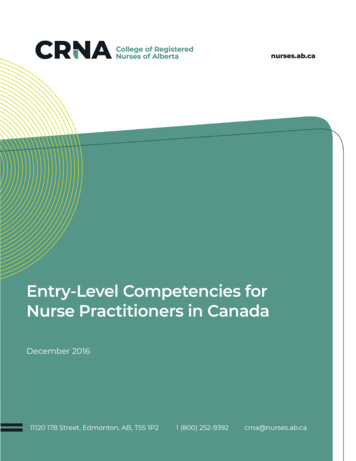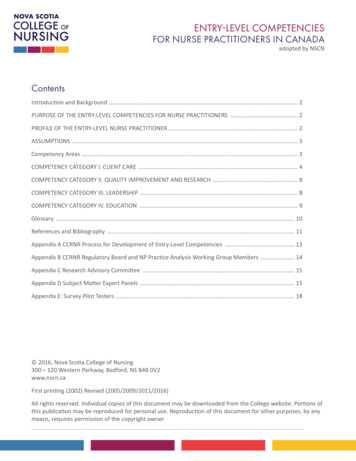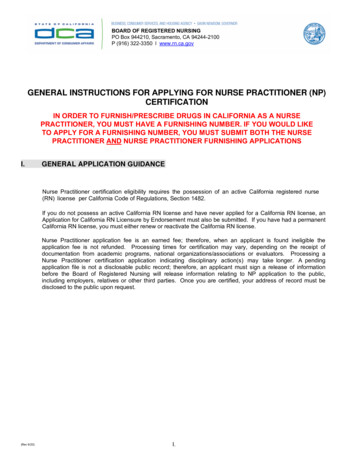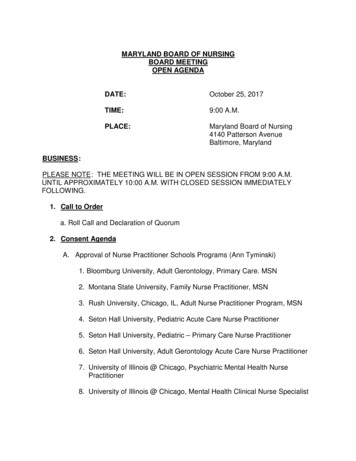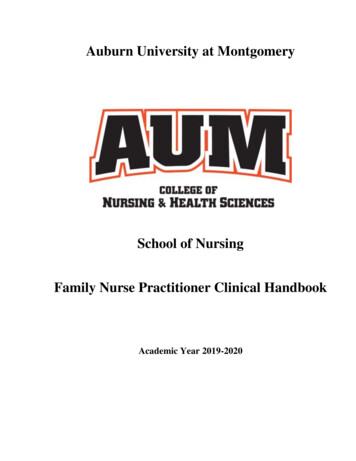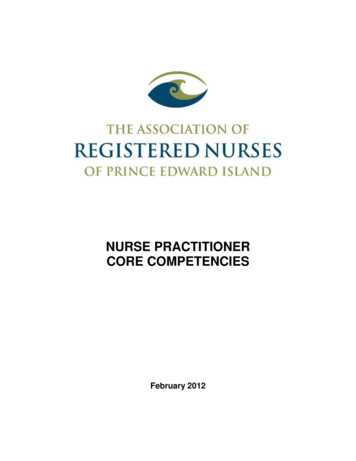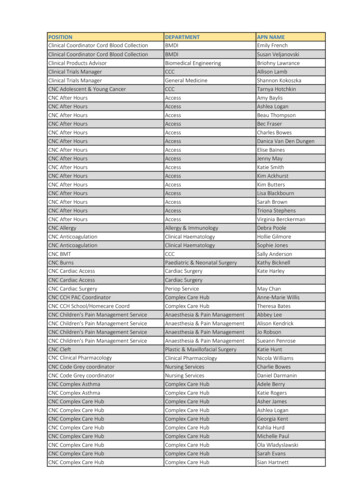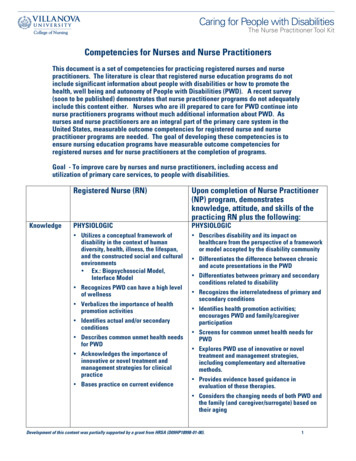
Transcription
Nurse Practitioner EducationCompetencies for PrescribingControlled Drugs and Substances1
Canadian Association of Schools of Nursing, 2016Suggested citation: Canadian Association of Schools of Nursing. (2016). Nurse Practitioner Education Competencies for Prescribing Controlled Drugs and Substances. Ottawa, ON: Author.2
Table of ContentsAcknowledgments1Background3Key Considerations4Methods5Competency Framework6Nurse Practitioner Education Competencies forPrescribing Controlled Drugs and Substances7Glossary of Terms11References123
AcknowledgementsThe Canadian Association of Schools of Nursing (CASN) gratefully acknowledges the expertise,time, and contribution of all those who engaged in the development of the Nurse Practitioner Education Competencies for Prescribing Controlled Drugs and Substances. In addition to the project’sCompetency Development Working Group and Advisory Committee, we would like to thank thosewho provided their feedback and expertise at either the in-person stakeholder forum or throughthe online survey.Development and mobilization of appropriate prescriber practice competencies for controlleddrugs and substances into nurse practitioner and registered nurse education programs projectCompetency Development Working GroupRuth Martin-Misener (Co-chair), RN-NP, PhDDalhousie UniversityLynn Miller (Co-chair), DNP, NPCollege of Registered Nurses of Nova ScotiaKathleen F. Hunter, PhD, RN, NP, GNC(C) NCAUniversity of AlbertaRobert Nevin, RN-NPFamily Practice Clinic, Iqaluit, NUJosette Roussel, RN, MSc, M. Ed. l , inf. aut., M. Sc.,M. ÉdEric Staples, RN, DNPCanadian Nurses Association/ Association des infirmières et infirmiers du CanadaIndependent Nursing Practice ConsultantLinda M Van Pelt, MScN, NP-FShelley Walkerley, NP-PHC PhDUniversity of Northern British Columbia and NorthernHealthYork UniversityRosemary Wilson, PhD, RN(EC)Queen’s University1
Development and mobilization of appropriate prescriber practice competencies for controlled drugsand substances into nurse practitioner and registered nurse education programs project AdvisoryCommitteeRuth Martin-Misener (Co-chair), RN-NP, PhDDalhousie UniversityLynn Miller (Co-chair), DNP, NPCollege of Registered Nurses of Nova ScotiaMary Ellen Andrews, RN(NP), PhDUniversity of SaskatchewanCynthia Baker, RN, PhDCanadian Association of Schools of NursingDenise Bowen, MN, RNAurora College; CASN Board MemberDana S. Edge, PhD, RNQueen’s UniversityDebbie Fraser, MN, RNC-NICAthabasca UniversityKathleen F. Hunter, PhD, RN, NP, GNC(C) NCAUniversity of AlbertaLaura Johnson, DNP, MN, RN(NP)Vancouver Island UniversityJamie Kellar, RPh, BScHK, BScPhm, Pharm.DUniversity of TorontoRobert Nevin, RN-NPFamily Practice Clinic, Iqaluit, NUPat Nymark, RN BN MN NPAurora CollegeRoger Pilon, NP-PHC, DOCHN, MScN, PhDÉcole des Sciences Infirmières-Université LaurentienneJosette Roussel, RN, MSc, M. Ed. l , inf. aut., M.Sc., M. ÉdCanadian Nurses Association/ Association desinfirmières et infirmiers du CanadaEric Staples, RN, DNPIndependent Nursing Practice ConsultantLinda M Van Pelt, MScN, NP-FShelley Walkerley, NP-PHC PhDUniversity of Northern British Columbia and NorthernHealthYork UniversityRosemary Wilson, PhD, RN(EC)Queen’s UniversityFunding for this document is provided by the Government of Canada.The views expressed herein do not necessarily represent the views of the Government of Canada.2
BackgroundIn 2015 the Canadian Association of Schools of Nursing (CASN) received funding from HealthCanada’s Anti-Drug Strategy Initiatives program to carry out a project related to nursepractitioner (NP) education on prescribing controlled drugs and substances (CDS). The first partof the project was to develop a national, consensus-based framework of essential disciplinespecific, competencies for NP education on prescribing CDS in Canada. The purpose of theframework is to determine core content that all new NPs will need to have before prescribingCDS.Nurse practitioners provide essential care to people across health care settings. Thecompetencies and indicators delineate the essential knowledge, attitudes, and skills all new NPsshould possess related to prescribing CDS regardless of where they are employed followinggraduation. The ensuing competencies align with Canadian regulatory bodies’ entry-to-practicecompetencies for NPs that schools of nursing are required to integrate into program curricula.However, they are more detailed and specific in order to offer greater guidance to educators.In November 2012, Health Canada passed the New Classes of Practitioners Regulations whichauthorized NPs to prescribe controlled substances as outlined in Schedule I–Schedule V in theControlled Drug and Substances Act (CDSA). NPs are authorized to prescribe all controlled drugsand substances described in the act, with the exception of heroin, cannabis, opium, coca andanabolic steroids (other than testosterone) (Canadian Nurse, 2013).A controlled substance is defined by Health Canada (2012) as:“any type of drug that the federal government has categorized as having a higher-thanaverage potential for abuse or addiction. Such drugs are divided into categories based ontheir potential for abuse or addiction. Controlled substances range from illegal streetdrugs to prescription medications”.While the federal government has allowed for this increased scope of practice, implementationacross provincial and territorial regulatory bodies in Canada has varied. Currently, whichcontrolled substances NPs are authorized to prescribe, and what additional education isrequired for practicing NPs to prescribe them, differs by province/territory.3
Key ConsiderationsCanada is now the second largest consumer of opioids per capita in the world (The National AdvisoryCouncil on Prescription Drug Misuse, 2013, p.1). While prescription drugs have helped many clientsmanage pain, there has also been an increase in prescription drug misuse and diversion (Embrey,2012). Given the risks, prescribing CDS requires healthcare providers to have additional and advancedknowledge and skills in this area. Even if healthcare providers appropriately prescribe and administeropioids, they need to be aware of the possibility of prescription misuse and abuse. Current healthcareproviders with CDS prescribing authority are challenged to prescribe these substances to the patientswho need them and not to those who would use them for reasons other than their intended purpose(Arnstein & St. Marie, 2010).Prescribers need to be aware that CDS misuse is possible with any client. However there is evidencethat some populations are at a higher risk of adverse effects from controlled drugs and substances, forexample, infants, youth, and seniors. Infants are at risk of drug withdrawal if their mother was usingpsychoactive drugs during pregnancy. Infant and adolescent brains develop at a rapid pace which canbe negatively affected by the use of prescription drugs (The National Advisory Council on PrescriptionDrug Misuse, 2013). The quickly growing senior population presents different vulnerabilities tocontrolled drugs and substances. Seniors are more likely than the general population to experiencechronic pain and insomnia, and as a result, are more likely to receive prescriptions for opioids andbenzodiazepines. These medications can lead to a loss of coordination, confusion or drowsinesscausing falls, hip fractures and other adverse effects. It is important to note that these adverse effectscan occur even if the prescription is taken properly (Canadian Medical Association (CMA), 2014;National Advisory Council on Prescription Drug Misuse, 2013; Pham & Dickman, 2007).Youth are also at a higher risk for prescription drug misuse. One contributing factor is the illusionsome youth have that prescription drugs are safer than illegal drugs. A survey of Ontario students ingrades 7-12 found that 14% reported the non-medical use of opioid pain relievers during 2011. Ofthose, 72% obtained the drugs from home, and 6% reported obtaining them from friends (TheNational Advisory Council on Prescription Drug Misuse, 2013).Although more research is needed on the prevalence of prescription drug abuse and misuse amongCanada’s First Nations population, some statistics show that First Nation populations are at adisproportionately high risk of prescription drug abuse. In 2012, Federal Government funding wasallocated to support a First Nation community in Ontario where 80% of the community reportedlyabuses prescription drugs (Lewis, 2012). The origins of this problem are longstanding and complex androoted in the legacy of residential schools and colonialism.Prescribing controlled drugs and substances is an intricate practice of balancing risks andbenefits. Increasing this complexity is that some patients are seeking prescription drugs with theintention of selling them to others or misusing the drugs themselves. In cases where diversion oroverdose occurs, the prescriber can be held liable (Arnstein & St. Marie, 2010). There are stepsprescribers can take to protect their patients from adverse effects and to reduce their legal risks. Thisincludes taking a thorough patient history, conducting a physical examination, collaborating withother health professionals, having informed consent discussions (including explaining the significanceof the medication and the potential implications of misuse and diversion), employing treatmentagreements and conducting random testing. Furthermore, proper documentation and charting canhelp the prescriber establish that they have met the standard of care (Gallegos, 2013).4
MethodsThe purpose of the project is to promote competent, high quality CDS prescribing practices among NPsby providing NP programs with guidance and resources related to the prescription of CDS. An AdvisoryCommittee of experts from across Canada was struck to guide the project. The Advisory Committeewas divided into two working groups: the Competency Development Working Group and the EResource Working Group.CASN conducted an environmental scan of existing resources, standards, and competencies related toprescribing of controlled drugs and substances. Regulatory bodies across Canada have been revising ordeveloping amendments to their existing standards for NP practice to include the prescribing of CDS.These were reviewed and taken into consideration in the development of the CASN CDS prescribingcompetencies for NP programs. A search of the grey literature was also carried out to examine existingstandards and competencies related to prescribing CDS. Existing competencies/standards, bothnursing specific and interprofessional were reviewed, as well as other relevant Canadian andinternational documents. The review served as a starting point to develop an initial draft of the CASNNurse Practitioner Education Competencies for Prescribing Controlled Drugs and Substances.The draft competencies underwent a number of rounds of revisions by the Competency DevelopmentWorking Group and the Advisory Committee as a whole. Following these revisions, an in-personstakeholder forum was held. The Stakeholder Forum was attended by a wide array of stakeholdersfrom across Canada. The use of a world café format allowed for the different voices in the room to beheard as well as to facilitate an in-depth review of each competency and indicator statement. CASNcollated the feedback and the Working Group held a teleconference to review the feedback and revisethe competencies. The last step of the competency development process was to send out an onlinesurvey to obtain final feedback. With the use of the online program Fluid Surveys, a snowball samplingmethod was employed. The Advisory Committee was invited to distribute the online survey to theirnetworks. The survey was also sent to all NP programs in Canada and the stakeholder forumattendees. There were 80 responses to the survey, with an 81% completion rate.Respondents were asked to rate each competency and indicator statement as one of the following:“essential”, “important”, “somewhat important”, “not important”, or to indicate if they did not know.Respondents were also given the opportunity to provide comments throughout the survey. Eachcompetency and indicator statement achieved over 90% on the “essential” and “important” ranking.Given the level of agreement, the Competency Development Working Group met to review thecomments and only minor revisions were made to the document.5
Competency FrameworkThe competencies and indicators outlined in this document provide direction for NP programsacross Canada specifically related to CDS prescribing. They delineate the core knowledge,skills, and attitudes all NP students should attain over the course of their education in order toprescribe CDS safely and effectively.Competencies are complex know-acts based on combining and mobilizing internal resources(knowledge, skills, attitudes) and external resources, and applying them appropriately tospecific types of situations (Tardif, 2006). The indicators that accompany the competenciesare the assessable and observable manifestations of the critical learnings needed to developthe competency (Tardif, 2006).Prescribing is not a new role for NPs and is taught in all entry level NP education programs. Assuch, the competencies are based on the assumption that foundational prescribing practicesand related content are already taught in NP programs. Competencies expected of registerednurses to promote client safety in relation to CDS monitoring and harm reduction are notrepeated in this document. While repetition of competencies that apply to general prescribingwas avoided, some overlap is necessary due to the complexities associated with CDSprescribing and the associated level of accountability and responsibility.6
Nurse Practitioner EducationCompetencies for PrescribingControlled Drugs andSubstances7
Competency 1Prescribes and monitors the use of controlled drugs andsubstances (CDS) in accordance with federal/provincial/territorial legislation, regulation, andguidelines.Indicators1.11.21.3Demonstrates knowledge of evidence-informed guidelines, legislation,regulation and organizational policies when prescribing or dispensingCDS.Demonstrates an understanding of the impact of prescription monitoringsystems on CDS prescribing.Demonstrates knowledge and ability to use available prescriptionmonitoring systems.8
Competency 2Integrates concepts of safety, ethics and evidenceinformed practice in decision making pertaining toprescribing CDS.Indicators2.1Demonstrates knowledge and applies concepts of the pathophysiology ofconditions that may require treatment with CDS.2.2 Applies principles of pharmacotherapeutics of CDS when prescribing orplanning treatment.2.3 Demonstrates understanding of best practices related to the use of CDS and ofother pharmacological and non-pharmacological therapeutic options.2.4 Selects appropriate screening and diagnostic tools to assess safety concernsfor tolerance, dependence, substance use disorder patterns and diversion ofCDS.2.5 Demonstrates knowledge of potential risks for individuals, families,households and communities when prescribing CDS.2.6 Identifies when there is a need to collaborate with other providers intreatment planning and prescribing CDS.2.7 Performs medication reconciliation when prescribing CDS.9
Competency 3Develops and implements client-centred CDS treatmentplans which include education, monitoring andevaluation of outcomes.Indicators3.13. 23.33.43.53.6Demonstrates the ability to develop and implement a CDS treatment planthat includes the therapeutic objective and the expected response.Demonstrates the ability to counsel individuals and families about CDStreatment goals, risks and benefits, proper use, and potential side effects.Demonstrates an ability to titrate, taper, or discontinue CDS consideringrelevant guidelines and pharmacotherapeutics.Assesses, monitors, and documents inadequate, atypical, orinappropriate responses to CDS treatment.Initiates a CDS treatment contract when appropriate or required.Demonstrates and applies knowledge of the complexities of substanceuse disorders.10
GlossaryTermAbuseAddictionClient (patient)-centered careControlleddrugs finition“ characterized by a pattern of recurrent use where at least one of the followingoccurs: failure to fulfill major roles at work, school or home, use in physically hazardoussituations, recurrent alcohol or drug related problems, and continued use despite socialor interpersonal problems caused or intensified by alcohol or drugs.” (Statistics Canada,2015).“ uncontrollable use of one or more substances, associated with discomfort or distresswhen that use is discontinued or severely reduced.” (The Standing Senate Committeeon Social Affairs, Science and Technology, 2004, p.74)“Providing care that is respectful of and responsive to individual patient preferences,needs, and values, and ensuring that patient values guide all clinicaldecisions.” (Institute of Medicine, 2002, p.3)“Any type of drug that the federal government has categorized as having a higher-thanaverage potential for abuse or addiction. Such drugs are divided into categories basedon their potential for abuse or addiction range from illegal street drugs to prescriptionmedications” (Health Canada, 2012).“Dependence can be physical, psychological, or both. Physical dependence consists oftolerance (needing more of the substance for the same effect). Psychologicaldependence is present when a person perceives an intense need to use the substance inorder to function effectively or in particular situations. The degrees of dependencerange from mild to severe, the latter being characterized as addiction.” (The StandingSenate Committee on Social Affairs, Science and Technology, 2004, p.73).“Prescription drug diversion involves the unlawful redirecting of regulatedpharmaceuticals from legal sources to the illegal marketplace and can occur at all pointsalong the drug supply chain” (The National Advisory Council on Prescription DrugMisuse, 2013, p.73).“Prevention initiatives and activities must be guided by evidence, preferably thatprovided through documented scientific research. However, in the absence of a solidbase of evidence, evidence-informed prevention approaches can be used. They allow forinnovation while incorporating lessons learned from existing research literature and areresponsive to cultural backgrounds and community values, among otherthings.” (Canadian Centre on Substance Abuse, 2015, p.7)Medicationreconciliation“Medication reconciliation is a systematic and comprehensive review of all themedications a patient is taking to ensure that medications being added, changed ordiscontinued are carefully assessed and documented.”(Accreditation Canada, the Canadian Institute for Health Information, the CanadianPatient Safety Institute, and the Institute for Safe Medication Practices Canada, 2012).Misuse“Misuse can be broadly defined as the use of medications for purposes other than theindication for which the drug was prescribed” (The National Advisory Council onPrescription Drug Misuse, 2013, p.73).“ [the] body becomes used to the drug and it requires a larger dose to achieve thesame effects. As with many other drugs, a sudden stop in the use of the drug after a longperiod of use can cause the individual to experience withdrawal symptoms.” (RoyalCanadian Mounted Police, 2013)Tolerance11
ReferencesAccreditation Canada, the Canadian Institute for Health Information, the Canadian Patient SafetyInstitute, and the Institute for Safe Medication Practices Canada. (2012). Medication reconciliation in Canada: Raising the bar – progress to date and the course ahead. Ottawa, ON: Accreditation Canada.Arnstein, P. & St. Marie, B. (2010). Managing chronic pain with opioids: A call for change. Bellevue,WA: Nurse Practitioner Healthcare Foundation.Canadian Centre on Substance Abuse. (2015). Competencies for the youth substance use preventionworkforce: Prevention workforce competencies report. Ottawa, ON: Canadian Centre on Substance Abuse.Canadian Medical Association. (2014). Review of controlled drugs and substances act. Retrievedfrom en/advocacy/CMA SubmissiontoHealthCanada-CDSA Modernization.pdfCanadian Nurse. (2013). Expanded prescribing authority. Retrieved from rey, M.L. (2012). Gaining insights from students in recovery from prescription drug abuse: Didschool nurses report an influence on their practice? NASN School Nurse, 27(3), 166-169.Gallegos, A. (2013). Physician liability: When an overdose brings a lawsuit. American Medical News.Retrieved from www.amednews.com.Health Canada. (2012). Controlled substances and precursor chemicals. Retrieved from eng.php.Institute of Medicine. (2002). Crossing the quality chasm: A new health system for the 21st century.Washington, DC: National Academy Press.Lewis, S. (2012). Combating prescription drug addiction a priority. Windspeaker, 30 (5).National Advisory Council on Prescription Drug Misuse. (2013). First do no harm: Responding to Canada’s prescription drug crisis. Ottawa: Canadian Center on Substance Abuse.Pham, C. & Dickman, R. (2007). Minimizing adverse drug events in older patients. American FamilyPhysician, 76(12), 1837-1844.Royal Canadian Mounted Police. (2013). Illegal drugs. Retrieved from l-eng.htmStanding Senate Committee on Social Affairs, Science and Technology. (2004). Interim report onmental health, mental illness and addiction. Retrieved from ci/rep/report1/repintnov04vol1-e.pdf.Statistics Canada. (2015). Heath at a glance: Mental health and substance use disorders. Retrievedfrom cle/11855-eng.htm.Tardif, J. (2006). L’évaluation des compétences. Documenter le parcours de développement. Montréal, QB: Chenelière Education.12
13
Nurse Practitioner Education Competencies for Prescribing Controlled Drugs and Substances. The draft competencies underwent a number of rounds of revisions by the ompetency Development Working Group and the Advisory ommittee as a whole. Following these revisions, an in-person stakeholder forum was held.
